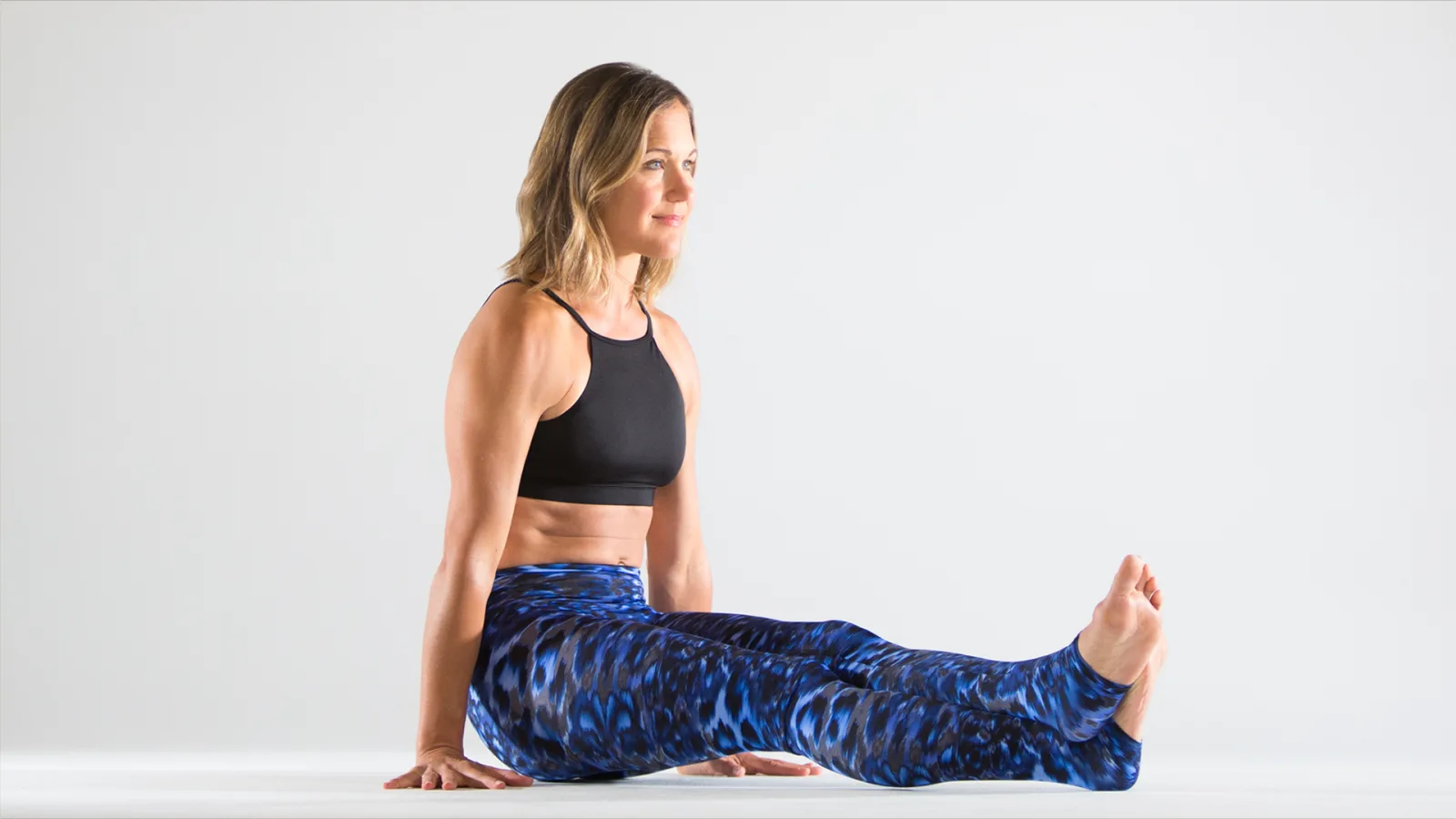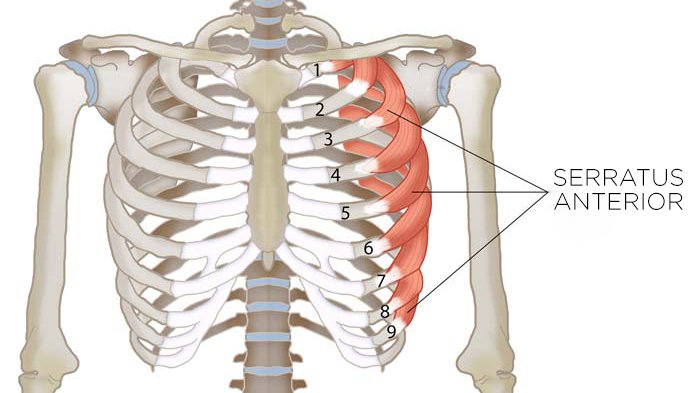
Three Ways to Target the Serratus Anterior
How often have you heard the term “serratus anterior” dropped during yoga class? While it’s not a completely mysterious area—you may have heard it referred to as your “bear hug” muscle—it does tend to get less attention than other muscles. This could be because it’s a mouthful to say or because muscle-themed classes tend to focus on larger muscles or groups of muscles (such as the hamstrings or quadriceps).
The serratus anterior is a multi-segmented muscle that originates at the upper eight or nine ribs, and runs all the way to the medial side of the scapula. First, it plays a role in protracting the shoulder blades (moving them away from each other). It is also responsible for stabilizing and holding the shoulder blades against the rib cage. These actions support the actions of the major upper back, shoulder, and chest muscles in postures like plank, chaturanga dandasana (four-limbed staff pose), and most arm balances and inversions.

What's so important about the serratus anterior? The serratus anterior muscles are also key players in upward shoulder rotation and movement, which includes anytime you bring your arms overhead, as in virabhadrasana I (warrior I) or adho mukha vrksasana (handstand).
For many of us, though, these muscles are simultaneously tight and weak. Our forward-head culture, with our head and neck constantly jutting in front of our thoracic spine as we text and type, tends to encourage a rounded upper back and constantly protracted shoulder blades.
Over time, this can lead the always “on” and contracted serratus anterior muscle fibers to become chronically shortened. It is easy for them to lose elasticity and potentially atrophy (hence the muscle tightness yet weakness).
As a result, other muscles will attempt to create stability by taking on more of the load. This may further contribute to weak serratus anterior muscles and even neck pain and shoulder impingement (most often caused by overused or irritated rotator cuff muscles).
This will often manifest as referred tension or pain in the neck area, especially along the upper trapezius, which often makes people think that’s the area to stretch or massage (and leads to further neglect of the serratus anterior muscles).
Having a weaker serratus anterior may not initially prevent you from accessing certain postures, but over time its lack of strength can exacerbate muscular imbalance, which may lead to muscle injuries.
Finally, because the serratus anterior muscles, along with the serratus posterior muscles, play an important role in maintaining upright posture by keeping the rib cage lifted and supporting full expansion of the lungs, weak serratus muscles can even contribute to shallow breathing.
If you find that moving your arms overhead tends to be something of a process, your rhomboid or upper trapezius muscles are often achy, or you notice your head jutting forward (and the rounded shoulders and tight chest that go with it), bringing some attention to your serratus anterior muscles may provide relief with those issues.
Are your shoulder blades winging off your back? The way your shoulder blades act when you’re standing upright—say, in tadasana (mountain pose)—provides more information about whether your serratus anterior muscles could use some stretching and strengthening. For example, are your shoulder blades close to your spine and flat against your back as you maintain a broad chest in your tadasana? (Good news!)
Do they maintain that positioning in your planks and chaturangas? Or do you notice one or both shoulder blades “winging” off your back? In doing so they create a valley between the shoulder blade and your spine because the medial bottom edge of the blade lifts, and therefore is not staying flush against the back.
Winged scapulae are associated with nerve dysfunction in the area, often as a result of trauma or overuse. Whether you have any of these issues or are simply trying to find more strength in the serratus anterior muscles to support your arm balancing postures, you may benefit from the targeted lengthening and strengthening exercises below.
I recommend doing each exercise at least ten times, and completing two or three consecutive sets if you can. After some regular practice, you may notice that you’re functionally engaging your serratus anterior muscles in your daily activities.
Helpful props: a folded blanket or a block, two half-width blocks, and a friend (to notice what your shoulder blades are doing!).
Dandasana (Staff Pose) Floor Push
Begin in dandasana. If your lower back is rounding, or your hips or hamstrings are tight, sit on either a folded blanket or the widest surface of your block. Flex your feet and keep them active.
Stabilize yourself by rooting firmly through your sitting bones, and then stretch out through your legs and heels, as if you were standing on them. Engage the thighs, rotating them slightly inward while keeping your knees and toes pointing up toward the ceiling.
Reach up through the top of your head, finding as much length in the spine as possible, while maintaining a straight line from crown to sacrum. Place one of your palms on either side of your hips. If you need to bring the floor closer to you, place two half-width yoga blocks, sturdy books of equal width, or another flat, supportive, non-slipping prop under each hand.
Begin pushing the floor away, straightening your arms, as you draw the front of your shoulders back. Then slightly bend your elbows straight back. You should notice a sensation at the back edge of your armpit. Continue to reach up through the crown of your head. Notice the lift of your rib cage.
Hold here for three breaths, then release. You will gradually extend the length of time that you hold this position.
As your strength builds, you may want to add weight to the exercise by crossing your ankles and lifting your sit bones from the floor as you push into the ground.
Scapular Movement in Alternating Arm Raises
Begin in tabletop (hands and knees). Place your knees directly under your hips and your wrists and elbows under your shoulders. Maintain a neutral spine by gazing at the floor a few inches ahead of you.
Draw the lower belly in to engage the abdominals. Push firmly through your left hand as you walk your right fingertips forward and just slightly to the right, so that your right arm is at a diagonal to your right shoulder.
Lift your arm about halfway to shoulder height and turn your palm to face in (pinky fingers down). Slightly bend your right elbow to bring some length across the top of your right shoulder (avoid dumping into or crunching this area).
From here, continue to keep your head lifted, and gaze forward as you inhale and straighten your arm, reaching out through your fingertips.

On an exhale, bend your elbow back toward the bottom of your right rib cage, retracting your right shoulder blade and coming into a “goalpost” arm.
Re-extend your right arm and release your right hand to the floor, returning to table. Repeat on the left side, then alternate from side to side until you’ve completed ten on each side.
Scapular Push-ups in Modified Plank
Begin in a plank position on your knees. (Pad your knees with a folded blanket, if needed.) Broaden across your chest, externally rotate your upper arms as if you’re trying to bring your triceps closer to your rib cage, and retract your shoulder blades as if you’re trying to bring their inner edges together.
Keep your entire belly toned and engaged. Hold for one breath, then push the floor away as you slightly round your back, protracting your shoulder blades. Hold for one breath, and then slightly drop your chest as you retract your shoulder blades, drawing them back toward each other.

Note that your arms will not move much during the exercise, if at all. Your chest will drop a few inches as your shoulder blades retract, and then lift as they protract. All movement will take place within your shoulder girdle.
Tip: If you find that your shoulder blades still “wing” considerably in the retraction portion of the exercise, begin this practice in tabletop and work your way to the modified plank position. As your strength builds, consider practicing scapular push-ups in full plank position.